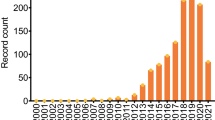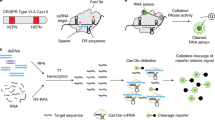Abstract
MicroRNA detection is crucial for early infectious disease diagnosis and rapid cancer screening. However, conventional techniques like reverse transcription-quantitative polymerase chain reaction, requiring specialized training and intricate procedures, are less suitable for point-of-care analyses. To address this, we’ve developed a straightforward amplifier based on an exonuclease III (exo III)-propelled DNAzyme walker for sensitive and selective microRNA detection. This amplifier employs a specially designed hairpin probe with two exposed segments for strand recognition. Once the target microRNA is identified by the hairpin’s extended single-strand DNA, exo III initiates its digestion, allowing microRNA regeneration and subsequent hairpin probe digestion cycles. This cyclical process produces a significant amount of DNAzyme, leading to a marked reduction in electrochemical signals. The biosensor exhibits a detection range from 10 fM to 100 pM and achieves a detection limit of 5 fM (3σ criterion). Importantly, by integrating an “And logic gate,” our system gains the capacity for simultaneous diagnosis of multiple microRNAs, enhancing its applicability in RNA-based disease diagnostics.
Graphical Abstract







Similar content being viewed by others
References
Ambros V (2004) The functions of animal microRNAs. Nature 431:350–355
Fabian MR, Sonenberg N, Filipowicz W (2010) Regulation of mRNA translation and stability by microRNAs. Annu Rev Biochem 79:351–379
Zhai F-H, Zhan Q-Q, Wang K, Chen S, He R-H (2020) A homogeneous DNA nanosphere for fluorescence detection of microRNAs with high-ordered aggregation enhanced emission and enzyme-free cascade amplification. Sens Actuators, B Chem 320:128394
Joglekar MV, Joglekar VM, Hardikar AA (2009) Expression of islet-specific microRNAs during human pancreatic development. Gene Expr Patterns 9:109–113
Plasterk RH (2006) Micro RNAs in animal development. Cell 124:877–881
Xu F, Shi H, He X, Wang K, He D, Guo Q et al (2014) Concatemeric dsDNA-templated copper nanoparticles strategy with improved sensitivity and stability based on rolling circle replication and its application in microRNA Detection. Anal Chem 86:6976–6982
Cho WCS (2010) MicroRNAs in cancer — from research to therapy, Biochimica et Biophysica Acta (BBA). Rev Cancer 1805(2010):209–17
Peng H, Newbigging AM, Reid MS, Uppal JS, Xu J, Zhang H et al (2020) Signal amplification in living cells: a review of microRNA detection and imaging. Anal Chem 92:292–308
Wu Z, Liu G-Q, Yang X-L, Jiang J-H (2015) Electrostatic nucleic acid nanoassembly enables hybridization chain reaction in living cells for ultrasensitive mRNA imaging. J Am Chem Soc 137:6829–6836
Huang J, Zong C, Shen H, Liu M, Chen B, Ren B et al (2012) Mechanism of cellular uptake of graphene oxide studied by surface-enhanced Raman spectroscopy. Small 8:2577–2584
Causa F, Aliberti A, Cusano AM, Battista E, Netti PA (2015) Supramolecular spectrally encoded microgels with double strand probes for absolute and direct miRNA fluorescence detection at high sensitivity. J Am Chem Soc 137:1758–1761
Berezikov E, Cuppen E, Plasterk RHA (2006) Approaches to microRNA discovery. Nat Genet 38:S2–S7
Huang Z, Chen J, Luo Z, Wang X, Duan Y (2019) Label-free and enzyme-free colorimetric detection of Pb2+ based on RNA cleavage and annealing-accelerated hybridization chain reaction. Anal Chem 91:4806–4813
Fakhri N, Abarghoei S, Dadmehr M, Hosseini M, Sabahi H, Ganjali MR (2020) Paper based colorimetric detection of miRNA-21 using Ag/Pt nanoclusters. Spectrochim Acta Part A Mol Biomol Spectrosc 227:117529
Li R, Liu Q, ** Y, Li B (2020) Sensitive colorimetric determination of microRNA let-7a through rolling circle amplification and a peroxidase-mimicking system composed of trimeric G-triplex and hemin DNAzyme. Microchim Acta 187:139
Khakbaz F, Mahani M (2017) Micro-RNA detection based on fluorescence resonance energy transfer of DNA-carbon quantum dots probes. Anal Biochem 523:32–38
Wanunu M, Dadosh T, Ray V, ** J, McReynolds L, Drndić M (2010) Rapid electronic detection of probe-specific microRNAs using thin nanopore sensors. Nat Nanotechnol 5:807–814
Zhang Y-W, Liu W-S, Chen J-S, Niu H-L, Mao C-J, ** B-K (2020) Metal-organic gel and metal-organic framework based switchable electrochemiluminescence RNA sensing platform for Zika virus. Sens Actuators, B Chem 321:128456
Xu Y, Zhang Y, Sui X, Zhang A, Liu X, Lin Z et al (2021) Highly sensitive homogeneous electrochemiluminescence biosensor for microRNA-21 based on cascaded signal amplification of target-induced hybridization chain reaction and magnetic assisted enrichment. Sens Actuators, B Chem 344:130226
Wang H, Zhang Q, Yin H, Wang M, Jiang W, Ai S (2017) Photoelectrochemical immunosensor for methylated RNA detection based on g-C3N4/CdS quantum dots heterojunction and Phos-tag-biotin. Biosens Bioelectron 95:124–130
You X-J, Liu T, Ma C-J, Qi C-B, Tong Y, Zhao X et al (2019) Determination of RNA hydroxylmethylation in mammals by mass spectrometry analysis. Anal Chem 91:10477–10483
Xu Y, Li D, Cheng W, Hu R, Sang Y, Yin Y et al (2016) Chemiluminescence imaging for microRNA detection based on cascade exponential isothermal amplification machinery. Anal Chim Acta 936:229–235
Li Z, Yang H, Hu M, Zhang L, Ge S, Cui K et al (2020) Cathode Photoelectrochemical paper device for microRNA detection based on cascaded photoactive structures and hemin/Pt nanoparticle-decorated DNA dendrimers. ACS Appl Mater Interfaces 12:17177–17184
Wang H-Y, Ruan Y-F, Zhu L-B, Shi X-M, Zhao W-W, Chen H-Y et al (2021) An integrated electrochemical nanodevice for intracellular RNA collection and detection in single living cell. Angew Chem Int Ed 60:13244–13250
Hakimian F, Ghourchian H (2020) Ultrasensitive electrochemical biosensor for detection of microRNA-155 as a breast cancer risk factor. Anal Chim Acta 1136:1–8
Cheng W, Ma J, Cao P, Zhang Y, Xu C, Yi Y et al (2020) Enzyme-free electrochemical biosensor based on double signal amplification strategy for the ultra-sensitive detection of exosomal microRNAs in biological samples. Talanta 219:121242
Wei F, Wang J, Liao W, Zimmermann BG, Wong DT, Ho C-M (2008) Electrochemical detection of low-copy number salivary RNA based on specific signal amplification with a hairpin probe. Nucleic Acids Res 36:e65
Cao Y, Zheng Z, Monbouquette HG (2021) Nucleic acid amplification-free detection of DNA and RNA at ultralow concentration. Curr Opin Biotechnol 71:145–150
Kashir J, Yaqinuddin A (2020) Loop mediated isothermal amplification (LAMP) assays as a rapid diagnostic for COVID-19. Med Hypotheses 141:109786
Deng R, Zhang K, Sun Y, Ren X, Li J (2017) Highly specific imaging of mRNA in single cells by target RNA-initiated rolling circle amplification. Chem Sci 8:3668–3675
Chai H, Wang M, Tang L, Miao P (2021) Ultrasensitive electrochemical detection of miRNA coupling tetrahedral DNA modified gold nanoparticles tags and catalyzed hairpin assembly. Anal Chim Acta 1165:338543
Chu Y, Deng A-P, Wang W, Zhu J-J (2019) Concatenated catalytic hairpin assembly/hyperbranched hybridization chain reaction based enzyme-free signal amplification for the sensitive photoelectrochemical detection of human telomerase RNA. Anal Chem 91:3619–3627
Dong J, Cui X, Deng Y, Tang Z (2012) Amplified detection of nucleic acid by G-quadruplex based hybridization chain reaction. Biosens Bioelectron 38:258–263
Wu H, Zhou W-J, Liu L, Fan Z, Tang H, Yu R-Q et al (2020) In vivo mRNA imaging based on tripartite DNA probe mediated catalyzed hairpin assembly. Chem Commun 56:8782–8785
Wang K, He M-Q, Zhai F-H, He R-H, Yu Y-L (2017) A label-free and enzyme-free ratiometric fluorescence biosensor for sensitive detection of carcinoembryonic antigen based on target-aptamer complex recycling amplification. Sens Actuators, B Chem 253:893–899
Zhang K, Wang K, Zhu X, **e M (2017) Entropy-driven reactions in living cells for assay let-7a microRNA. Anal Chim Acta 949:53–58
He L, Lu D, Liang H, **e S, Zhang X, Liu Q et al (2018) mRNA-initiated, three-dimensional DNA amplifier able to function inside living cells. J Am Chem Soc 140:258–263
Li S, Li P, Ge M, Wang H, Cheng Y, Li G et al (2020) Elucidation of leak-resistance DNA hybridization chain reaction with universality and extensibility. Nucleic Acids Res 48:2220–2231
Miao P, Tang Y (2020) Dumbbell hybridization chain reaction based electrochemical biosensor for ultrasensitive detection of exosomal miRNA. Anal Chem 92:12026–12032
Srinivas N, Parkin J, Seelig G, Winfree E, Soloveichik D (2017) Enzyme-free nucleic acid dynamical systems. Science 358:eaal2052
Olson X, Kotani S, Padilla JE, Hallstrom N, Goltry S, Lee J et al (2017) Availability: a metric for nucleic acid strand displacement systems. ACS Synth Biol 6:84–93
Ang YS, Yung L-YL (2016) Rational design of hybridization chain reaction monomers for robust signal amplification. Chem Commun 52:4219–4222
**a N, Cheng J, Tian L, Zhang S, Wang Y, Li G (2023) Hybridization chain reaction-based electrochemical biosensors by integrating the advantages of homogeneous reaction and heterogeneous detection. Biosensors 13:543
**a N, Sun T, Liu L, Tian L, Sun Z (2022) Heterogeneous sensing of post-translational modification enzymes by integrating the advantage of homogeneous analysis. Talanta 237:122949
**a N, Sun Z, Ding F, Wang Y, Sun W, Liu L (2021) Protease biosensor by conversion of a homogeneous assay into a surface-tethered electrochemical analysis based on streptavidin–biotin interactions. ACS Sensors 6:1166–1173
Wu N, Wang K, Wang Y-T, Chen M-L, Chen X-W, Yang T et al (2020) Three-dimensional DNA nanomachine biosensor by integrating DNA walker and rolling machine cascade amplification for ultrasensitive detection of cancer-related gene. Anal Chem 92:11111–11118
Wang K, He M-Q, Zhai F-H, Wang J, He R-H, Yu Y-L (2018) Autonomous DNA nanomachine based on cascade amplification of strand displacement and DNA walker for detection of multiple DNAs. Biosens Bioelectron 105:159–165
Wang K, Fan D, Liu Y, Wang E (2015) Highly sensitive and specific colorimetric detection of cancer cells via dual-aptamer target binding strategy. Biosens Bioelectron 73:1–6
Liu W, Su M, Chen A, Peng K, Chai Y, Yuan R (2022) Highly efficient electrochemiluminescence based on luminol/MoS2 quantum dots@zeolitic imidazolate framework-8 as an emitter for ultrasensitive detection of microRNA. Anal Chem 94:9106–9113
Sidransky D (1997) Nucleic acid-based methods for the detection of cancer. Science 278:1054–1058
Jung R, Petersen K, Krüger W, Wolf M, Wagener C, Zander A et al (1999) Detection of micrometastasis by cytokeratin 20 RT-PCR is limited due to stable background transcription in granulocytes. Br J Cancer 81:870–873
Mo L, Mo M, Liang D, Yang C, Lin W (2023) Simultaneous detection and imaging of two specific miRNAs using DNA tetrahedron-based catalytic hairpin assembly. Talanta 265:124871
Sharafeldin M, Rusling JF (2023) Multiplexed electrochemical assays for clinical applications. Curr Opin Electrochem 39:101256
Adam H, Gopinath SCB, Md Arshad MK, Adam T, Hashim U, Sauli Z et al (2023) Integration of microfluidic channel on electrochemical-based nanobiosensors for monoplex and multiplex analyses: an overview. J Taiwan Inst Chem Eng 146(2023):104814
Funding
This work is financially supported the Natural Science Foundation of China (51572044, 21475018), and the Fundamental Research Fund for the Central Universities (N160504010).
Author information
Authors and Affiliations
Corresponding author
Ethics declarations
Competing interests
The authors declare no competing interests.
Additional information
Publisher's Note
Springer Nature remains neutral with regard to jurisdictional claims in published maps and institutional affiliations.
Supplementary Information
Below is the link to the electronic supplementary material.
Rights and permissions
Springer Nature or its licensor (e.g. a society or other partner) holds exclusive rights to this article under a publishing agreement with the author(s) or other rightsholder(s); author self-archiving of the accepted manuscript version of this article is solely governed by the terms of such publishing agreement and applicable law.
About this article
Cite this article
Li, D., Huang, Q. & Wang, K. Exonuclease III-propelled DNAzyme walker: an electrochemical strategy for microRNA diagnostics. Microchim Acta 191, 173 (2024). https://doi.org/10.1007/s00604-024-06208-4
Received:
Accepted:
Published:
DOI: https://doi.org/10.1007/s00604-024-06208-4




